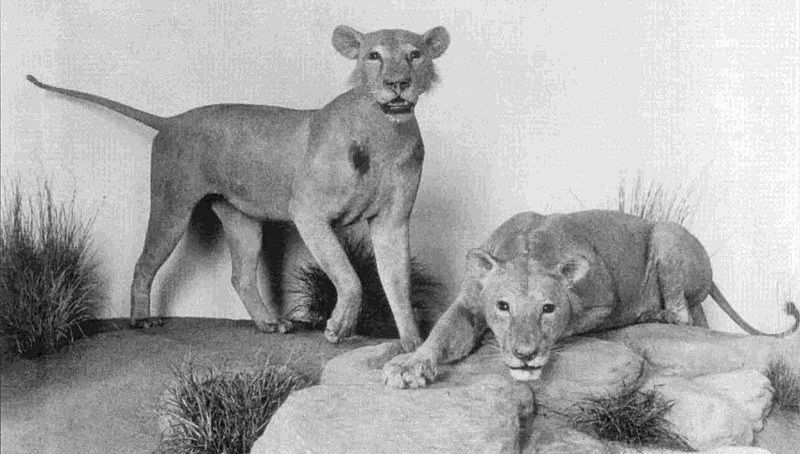Footnotes:
We humans consider ourselves removed from the food chain. We’ve moved past the days when “Here be monsters” was relevant on our maps. But nature abhors a vacuum, and when there are no monsters left to give us nightmares, sometimes an otherwise ordinary animal steps up to the challenge.

Two such animals thwarted the mighty British Empire at a time when it had designs on establishing control in East Africa. In 1898, Britain sought to bring civilization to the “savage” continent and endeavored to do so by building a railroad system from the coast to the interior.

The Kenya-Uganda Railway would run from the port-city Mombasa all the way through Lake Victoria to Port Florence, and allow opportunities for colonization all along the path. Britain expected the line to span 580 miles and take roughly three decades to complete, earning it the nickname “Lunatic Line” from it’s naysayers who thought it was an impossible goal.

But the line had bigger problems. A pair of male lions began stalking the project in March of 1898, at a spot where the track required the construction of bridge to cross a river valley. The lions would wage a campaign of terror against the railway that would last until late December. The man-eating cats would kill dozens to possibly over a hundred men, depending on which sources you believe, and succeeding in halting all production on the line.

Britain sent a civil engineer and tiger hunter named J.H. Patterson to dispatch the cats and finish the bridge. For months, the two lions would run circles around him, exhibiting legendary cunning and durability that led the rail workers to believe they were demons in disguise. Patterson would eventually defeat The Ghost and The Darkness, as the men took to calling them, collecting his harrowing journal entries in a book titled The Man Eaters of Tsavo. The story has been adapted into several movies over the last century, most notably Bwana Devil (1952), the first real 3D movie, and more recently The Ghost and The Darkness (1996) starring Val Kilmer and Michael Douglas.
But what spurred the lions to turn to man-eating in the first place? Were they truly “devils in lions’ shape,” as Patterson wrote in his book? Or were there environmental factors and pressures pushing them into conflict with humanity? It seems that poor health, starvation, and earlier human interference may all be candidates for inciting the lions’ historic rampage.


Whatever their motivations, the tale of The Ghost and The Darkness remains one of the most well-documented occurrences of man-eating animals of all time. Patterson eventually sold the lions’ remains to the Field Museum in Chicago in 1928, where they remain on display as a monument to nature’s indifference to human ambitions.

Sources:
Which animal is the deadliest hunter on the planet? by Ella Davies
That Cuddly Kitty Is Deadlier Than You Think by Natalie Angier
Tsavo Man-Eaters: The True Story of the Ghost and the Darkness by Lenny Flank
Two Egg, Florida: A Collection of Ghost Stories, Legends and Unusual Facts by Dale Cox
The Tale of Two-Toed Tom, The Demon Gator by Brent Swancer
Tsavo Man Eaters via Atlas Obscura
Man-eating lions ate fewer people than believed by Bruce Patterson
The strange history of the man-eating lions of Tsavo by John Platt
The Lions of Tsavo: Exploring the Legacy of Africa’s Notorious Man-Eaters by Bruce Patterson
The Man-Eaters of Tsavo by J.H. Patterson
Man-Eaters of Tsavo by Paul Raffaele
Museum Management:
Museum theme by Michael Guy Bowman
Listen to more at: bowman.bandcamp.com
Rachel: Designer #UkuleleWitch @rachelvice
Tour Guide: Emery Coolcats
Twitter: @natmysterycast | Email: natmysterypodcast@gmail.com | Home: pome-mag.com/category/pomecast
Museum of Natural Mystery is part of the POMEcast network, and thanks a million to the ladies of POME for helping this show get up and running! But above all, thank you for listening! We’ll see you next time!




